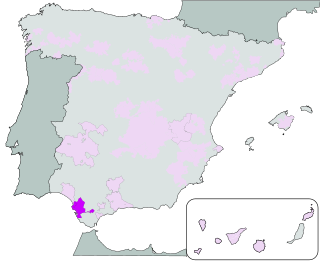
Sherry is a fortified wine made from white grapes that are grown near the city of Jerez de la Frontera in Andalusia, Spain. Sherry is a drink produced in a variety of styles made primarily from the Palomino grape, ranging from light versions similar to white table wines, such as Manzanilla and fino, to darker and heavier versions that have been allowed to oxidise as they age in barrel, such as Amontillado and oloroso. Sweet dessert wines are also made from Pedro Ximénez or Moscatel grapes, and are sometimes blended with Palomino-based sherries.

Solera is a process for aging liquids such as wine, beer, vinegar, and brandy, by fractional blending in such a way that the finished product is a mixture of ages, with the average age gradually increasing as the process continues over many years. The purpose of this labor-intensive process is the maintenance of a reliable style and quality of the beverage over time. Solera means "on the ground" in Spanish, and it refers to the lower level of the set of barrels or other containers used in the process; the liquid is traditionally transferred from barrel to barrel, top to bottom, the oldest mixtures being in the barrel right "on the ground". The containers in today's process are not necessarily stacked physically in this way but merely carefully labeled. Products which are often solera aged include Sherry, Madeira, Lillet, Port wine, Marsala, Mavrodafni, Muscat, and Muscadelle wines; Balsamic, Commandaria, some Vins doux naturels, and Sherry vinegars; Brandy de Jerez; beer; rums; and whiskies. Since the origin of this process is the Iberian peninsula, most of the traditional terminology is in Spanish and Portuguese.
In Spain, the denominación de origen is part of a regulatory geographical indication system used primarily for foodstuffs such as cheeses, condiments, honey, and meats, among others. In wines, it parallels the hierarchical systems of France (1935) and Italy (1963), although Rioja (1925) and Jerez (1933) preceded the full system. In foods, it performs a similar role, regulation of quality and geographical origin of products from Spain. There are five other designated categories solely for wine and a further three specifically covering food and condiments, all recognised by the European Union (EU). In Catalonia, two further categories – labelled A and Q – cover traditional Catalan artisan food products, but were not recognised by the EU as of 2007. In recent decades, the concept of the denominación de origen has been adopted by other countries, primarily in Latin America. In 2016, the use of the Denominación de Origen (DO) for wines was registered as a European Union Protected Designations of Origin/Denominación de Origen Protegida (PDO/DOP), but the traditional Portuguese term of DO can still be used legally on labels.
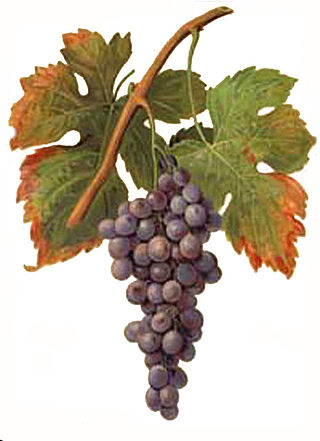
Palomino Fino is a white grape widely grown in Spain and South Africa, and best known for its use in the manufacture of sherry. It is also grown in the Douro region of Portugal where it is used for table and fortified wines.

Vin jaune is a special and characteristic type of white wine made in the Jura region in eastern France. It is similar to dry fino Sherry and gets its character from being matured in a barrel under a film of yeast, known as the voile, on the wine's surface. Vin jaune shares many similarities with Sherry, including some aromas, but unlike Sherry, it is not a fortified wine. The wine is made from the Savagnin grape, with some of the most premium examples coming from the marl based vineyards in the Château-Chalon AOC. In other French wine regions, there has been experimentation in producing similar style wines from Chardonnay and other local grape varieties using cultured yeast such as the vin de voile wine produced in the Gaillac.
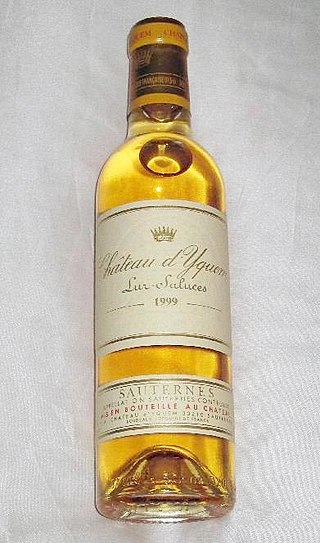
The subjective sweetness of a wine is determined by the interaction of several factors, including the amount of sugar in the wine, but also the relative levels of alcohol, acids, and tannins. Sugars and alcohol enhance a wine's sweetness, while acids cause sourness and bitter tannins cause bitterness. These principles are outlined in the 1987 work by Émile Peynaud, The Taste of Wine.

Pedro Ximénez is the name of a white Spanish wine grape variety grown in several Spanish wine regions but most notably in the denominación de origen (DO) of Montilla-Moriles. Here it is used to produce a varietal wine, an intensely sweet, dark, dessert sherry. It is made by drying the grapes under the hot sun, concentrating the sweetness, which are then used to create a thick, black liquid with a strong taste of raisins and molasses that is fortified and aged in solera.

Fino is the driest and palest of the traditional varieties of sherry and Montilla-Moriles fortified wine. They are consumed comparatively young and, unlike the sweeter varieties, should be consumed soon after the bottle is opened as exposure to air can cause them to lose their flavour within hours.

Amontillado is a variety of sherry wine characterised by being darker than fino sherry, but lighter than oloroso sherry. Amontillado wine is named after the Montilla municipality, in Andalusia, Spain, where the style of sherry originated in the 18th century; commercially, the name "Amontillado" is used as a measure of colour to label any style of sherry that lay between the categories of fino and oloroso. In American literature, Amontillado sherry features in the title of the short story "The Cask of Amontillado" (1846), by Edgar Allan Poe.

Manzanilla is a fortified wine similar to fino sherry made in the port of Sanlúcar de Barrameda, in the province of Cádiz, Andalusia (Spain), and is produced under the Spanish Denominación de Origen Protegida (DOP) of Manzanilla-Sanlúcar de Barrameda DOP. In Spanish, chamomile infusion is called "manzanilla", and thus this wine gets the name because the wine's aroma is said to be reminiscent of such infusion.

Flor in winemaking, is a film of yeast on the surface of wine, important in the manufacture of some styles of sherry. The flor is formed naturally under certain winemaking conditions, from indigenous yeasts found in the region of Andalucía in southern Spain. Normally in winemaking, it is essential to keep young wines away from exposure to air by sealing them in airtight barrels, to avoid contamination by bacteria and yeasts that tend to spoil it. However, in the manufacture of sherries, the slightly porous oak barrels are deliberately filled only about five-sixths full with the young wine, leaving "the space of two fists" empty to allow the flor yeast to take form and the bung is not completely sealed. The flor favors cooler climates and higher humidity, so the sherries produced in the coastal Sanlúcar de Barrameda and El Puerto de Santa María have a thicker cap of flor than those produced inland in Jerez. The yeast gives the resulting sherry its distinctive fresh taste, with residual flavors of fresh bread. Depending on the development of the wine, it may be aged entirely under the veil of flor to produce a fino or manzanilla sherry, or it may be fortified to limit the growth of flor and undergo oxidative aging to produce an amontillado or oloroso sherry.

The Classic Malts of Scotland is a selection of six single malt whiskies, launched and marketed together in 1988 by United Distillers and Vintners which is now owned by Diageo. They are often displayed together in bars and liquor stores. Diageo has since marketed other single malt labels and expressions with the Classic Malts labeling. The six original malts are:

Palo Cortado is a rare variety of sherry that is initially aged under flor to become a fino or amontillado, but inexplicably loses its veil of flor and begins aging oxidatively as an oloroso. The result is a wine with some of the richness of oloroso and some of the crispness of amontillado. Only about 1–2% of the grapes pressed for sherry naturally develop into palo cortado.
Andalusian cuisine is the regional cuisine of Andalusia, Spain. Notable dishes include gazpacho, fried fish, the jamones of Jabugo, Valle de los Pedroches and Trevélez, and the wines of Jerez, particularly sherry. The oldest known cookbook of Andalusian cuisine dates from the 14th century.

Spanish wine includes red, white, and sparkling wines produced throughout the country. Located on the Iberian Peninsula, Spain has over 1.2 million hectares planted in wine grapes, making it the most widely planted wine-producing nation, but the second largest producer of wine in the world, behind Italy and ahead of France and the United States. This is due, in part, to the very low yields and wide spacing of the old vines planted on the dry soils found in some of the Spanish wine regions. The country is ninth in worldwide consumption with Spaniards drinking, on average, 21.6 litres per person a year. The country has an abundance of native grape varieties, with over 400 varieties planted throughout Spain, though 88 percent of the country's wine production is from only 20 grapes — including the reds Tempranillo, Bobal, Garnacha, and Monastrell; the whites Albariño, Airén, Verdejo, Palomino, and Macabeo; and the three Cava grapes Parellada, Xarel·lo, and Macabeo.
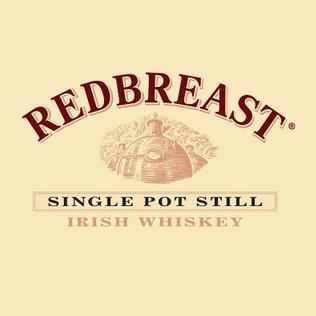
Redbreast is a brand of single pot still Irish Whiskey produced by the Irish Distillers subsidiary of Pernod Ricard. It was originally bottled by Gilbey's, a Dublin spirits merchant using distillate sourced from Jameson's Bow Street Distillery. In the 1980s, the brand was purchased by Irish Distillers, the producer of Jameson. It is the largest selling single pot still Irish whiskey in the world.

Montilla-Moriles is a Spanish Denominación de Origen Protegida (DOP) for wines located in the southern part of the province of Córdoba. It is bounded by the river Genil to the east, by the river Guadajoz to the west, by the river Guadalquivir to the north, and by the Subbetic Range of mountains to the south.
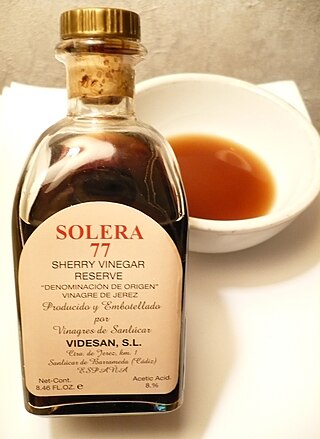
Sherry vinegar is a gourmet wine vinegar made from sherry. It is produced in the Spanish province of Cádiz and inside the triangular area between the city of Jerez de la Frontera and towns of Sanlúcar de Barrameda and El Puerto de Santa María, known as the "sherry triangle".

The history of Sherry is closely linked with that of Spanish wine production, particularly the political fortunes of the Cádiz region, where it originated with the early Phoenician settlement of the Iberian Peninsula. The triangular region between the towns of Jerez de la Frontera, El Puerto de Santa María, and Sanlúcar de Barrameda still marks the limits of the modern denominación. One of the world's oldest wines, its considerable evolution has been marked by the influence of many of the world's greatest empires and civilizations: the Phoenicians, Greeks, Romans, Moors, Spanish and British. Today, while Sherry does not enjoy the level of popularity it once did, it remains one of the wine world's most unusual and historical expressions.

Kavalan Distillery is a Taiwanese whisky distillery. It is owned by the King Car Group and is located at Yuanshan Township, Yilan County, Taiwan.


















